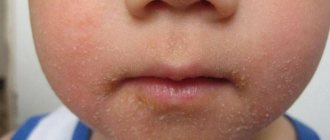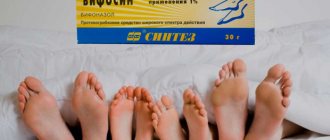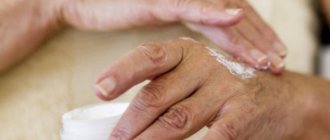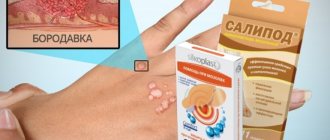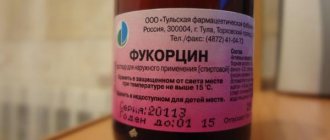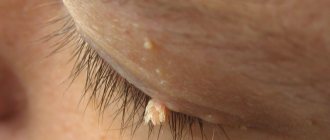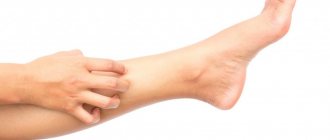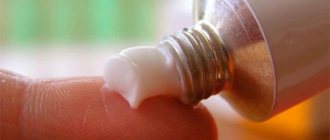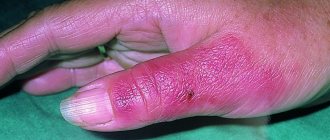A callus is a peculiar reaction of the skin that has been subjected to friction or pressure for a long time . Calluses are wet (watery), dry (hard) and core. Such formations appear due to various reasons:
- wearing the wrong shoes - tight, with rough seams inside, high heels;
- excess weight and carrying heavy objects, which leads to constant stress on the legs;
- the presence of problems such as diabetes, flat feet, blood problems;
- carrying specific physical loads, both work and sports.
Although calluses come in several varieties, the reasons for their appearance are always the same, and each type develops to a certain extent from the previous one: a dried bubble of water callus becomes coarser and turns into a dry callus, and that in turn, over time, grows like a rod deep into the skin and is classified as a core callus .
Photo 1. It is better to preserve blisters on a wet callus. This makes healing faster and safer. Source: Flickr (Chris Lewis)
Anti-callus patches
To speed up healing, you can use a special anti-callus patch:
- Compide - suitable for wet and dry corns, relieves pain, promotes rapid recovery;
- Leuko - disinfects, accelerates healing, prevents the penetration of bacteria;
- Salipod - softens keratinized tissue, suppresses inflammation, and has regenerating properties.
If the blister interferes with walking, and the patch does not reduce pain, then you should not wait for natural healing. In this case, it is necessary for the dropsy to burst. To do this, you need to carry out the following manipulation:
- disinfect the corns and nearby skin;
- make several punctures with a thin needle;
- let the liquid drain out, squeeze out the remaining residue with a dry cloth;
- Do not tear off the skin, but press it tightly to the wound and lubricate it with healing ointment (Levomekol, Bepanten).
httpv://www.youtube.com/watch?v=embed/_GOwpZT5Xc0
Causes
There is no specific age group that is particularly susceptible to developing calluses. Such a nuisance can happen to both young people and older people. And here's why this happens:
- The main reason, as we have already said, is shoes. New, uncomfortable, made of artificial materials. Just remember how often the thin strap of a new sandal rubs your foot. In addition, if, for example, on the beach, sand gets into your sneaker or shoe, most likely you will also come home with a rubbed bubble.
- The second reason is the lack of basic foot hygiene. If a person does not regularly use pumice to remove a layer of keratinized rough skin, then most likely he cannot avoid the appearance of calluses.
- It may also be a matter of the body’s tendency to develop calluses. People with this feature get rougher skin faster than others.
- If you do not want to suffer from calluses on your heels, do not wear socks made of synthetic materials, prefer cotton, linen or wool. Unfortunately, ladies' favorite tights and stockings also fall into this category.
Fast Healing Products
There are many pharmaceutical and folk remedies that are recommended to be used to smear calluses for quick healing if the surface of the blister is damaged:
- “Rescuer” ensures rapid healing and protects against suppuration;
- “Synthomycin liniment” helps to heal a wound during an inflammatory process;
- Vishnevsky balm is used to quickly cure purulent pathology;
- If you anoint the affected area with 10% Salicylic ointment, the treatment of wet calluses will be accelerated;
- To quickly cure inflamed dropsy, Levomekol ointment is used;
- For faster healing, it is recommended to treat a callus that has torn with an oil tincture of the herb St. John's wort (pour a glass of raw material into 0.5 liters of any vegetable oil and leave in the dark for 3 weeks). The pathology is treated by applying a gauze bandage soaked in the composition to the problem area.
Before applying pharmaceutical products to broken calluses on your feet, you must carefully read the instructions and follow their recommendations.
Should I pierce the callus myself?
If the water blister is large and prevents you from wearing shoes, you can help it break by piercing it yourself. Don't wait for the callus to burst at the wrong time and place. In this case, education can heal faster.
Before the procedure you need to prepare:
- Wash your hands thoroughly and treat them with alcohol;
- A needle (sewing pin, pin, syringe) must be calcined over an open fire (burning match, lighter, gas burner) or disinfected by dipping it in alcohol or iodine for 1-3 minutes;
- Treat the area around the callus on the foot, washing with warm water and laundry soap.
It is recommended to hold the needle parallel to the surface of the leg when piercing the callus. You need to make 2 holes through which to squeeze out the liquid that filled the blister and immediately treat the surgical site with an antiseptic. The product is applied with blotting movements, without removing the skin covering the wound. It is recommended to seal the callus with a bactericidal plaster; you can also use a callus plaster.
It is forbidden to pierce a callus on your own if the wet callus is festered or filled with bloody contents.
Signs of infection and treatment options
The inflammatory process when pathogenic microorganisms enter the wound from a burst callus is characterized by the following symptoms:
- Painful redness around the callus;
- Tumor of the problem area;
- Increased temperature of the whole body;
- Suppuration of the wound surface.
How to anoint a burst callus:
- Cut the spines along the edges of the aloe leaf and peel off the skin from the concave side. Apply the fleshy part to the wound and apply a gauze bandage. It is advisable to do the procedure at night;
- Apply a piece of Kalanchoe leaf, after removing its skin, to the inflamed wound;
- Before going to bed, steam the affected heel or toe in a warm solution of potassium permanganate. Wipe your leg dry, apply a plantain leaf, and apply a sterile bandage on top.
How to treat a wet callus with herbs
Young wet calluses are treated with medicinal plants. For example, plantain. As soon as the shoes begin to rub the skin, you need to pick a plantain leaf, wash it and crush it in your hands. Apply to the callus and secure the improvised compress with a bandage or adhesive plaster.
Plantain relieves pain, inflammation, disinfects and heals wounds. The only drawback of this method is that it is practically inapplicable in urban environments. Therefore, we have to look for other options for simple, effective treatment of soft calluses with folk remedies.
An excellent, completely safe remedy for dropsy on the legs, which can be used at home at a convenient time - baths made from decoctions of medicinal herbs. Chamomile and calendula are best suited for these purposes. Both plants are known for their wound-healing, antibacterial, and drying effects, so warm foot baths from decoctions of these herbs help to cope with soft calluses in just a couple of days.
In addition to baths to get rid of water calluses, you can make compresses from the pulp and juice of aloe and Kalanchoe:
Cut a small piece from a thick green leaf of aloe (Kalanchoe) and rinse with water.- Cut in half lengthwise.
- A slice with sticky pulp is applied to the callus.
- Cover the top with a sterile bandage.
- Secure the compress with a regular adhesive plaster.
This compress should be worn without touching for 24 hours. Then remove, treat the callus with an antiseptic and make a new compress. Continue treatment until the callus is completely healed.
First aid
A callus can appear on any part of the foot, but the heel is most often affected. How to quickly cure a callus that has burst on the heel:
- Remove the affected leg from shoes and clothing (socks, tights);
- Wash your hands with soap;
- Gently wash the area around the lesion with warm water and soap, being careful not to get any liquid into the wound;
- Treat the burst callus with any antiseptic (furatsilin solution, hydrogen peroxide, light pink solution of potassium permanganate);
- If the liquid inside the wound is free of blood, and the callus itself has not affected a large area of skin, you can fill the wound with BF-6 medical glue. The burning pain lasts literally 1-2 minutes. But then the wound is covered with a thin protective film, which prevents infection. A bactericidal patch should be glued on top of the treated surface;
- If the affected area is large, the wound should be smeared with antimicrobial ointment (Levomekol, Streptotsidovaya, Liniment synthomycin, etc.). Then it is recommended to apply a sterile bandage, which must be changed 2-3 times a day, while the ointment will protect the wound from infection by microbes and the bandage sticking.
Is it possible to smear calluses with brilliant green and iodine? This is of interest to patients who often develop dropsy. If you use the product on an open wound, you can get burned. In addition, the drugs greatly dry out delicate skin, causing cracks to appear on it.
If the surface of the dropsy is not broken, treatment is carried out using disinfecting compounds over the skin covering the wound. Zelenka protects it from inflammation. Potassium permanganate is used for daily baths, which speed up healing.
What to do if a callus on your foot bursts outside the home:
- Apply a plantain leaf to the wound with the glossy side, after washing or wiping it from dust and dirt. Put a sock on top;
- Pluck several carved yarrow leaves, chew them thoroughly until a homogeneous mass is obtained, and cover the wound with the resulting composition;
- If you don’t have familiar medicinal plants at hand, stick a leaf of birch, oak, poplar, or maple on the affected area;
- Remove the shoes that are rubbing your feet, otherwise the blister may break.
Arriving home, you should quickly and thoroughly treat the callus that has burst on the heel.
Folk recipes
To safely get rid of the resulting pathology, use home remedies.
Ingredients that every housewife will need, for example, onions, tomatoes, potatoes and others. Different products are used for different purposes.
Lotions and compresses
You can prepare a compress for dropsy from aloe. The juice of this plant has a beneficial effect on the condition of the skin. Aloe softens and moisturizes the epidermis.
To prepare the composition you will need:
- aloe leaves - they must be fresh, no more than 4 hours after they are cut;
- salicylic acid;
- parchment;
- bandage or plaster.
The preparation method involves grinding aloe and applying it to the damaged area:
1 Grind the leaves using a blender. It should be a paste.
2Add 3-4 drops of salicylic acid.
3Let it sit for 15 minutes.
4Pour the mixture onto parchment paper.
5Secure on the damaged area with a plaster or bandage.
Before applying the compress, the damaged area should be cleaned and rinsed with cool water. Aloe compress is applied throughout the night.
In the morning, it is recommended to take a herbal bath with cool water. The duration of the course is three nights.
Important! This compress should not be applied to an open wound.
In addition to aloe, you can use plantain or Kalanchoe.
Then the recipe for making a compress will not be different. A lemon lotion will help quickly get rid of the resulting formation. It is necessary to use citrus peel and pulp.
The lotion should be applied once per knock for 3-5 minutes. It can be fixed using the same bandage or plaster.
Decoctions for processing
To relieve the symptoms of inflammation, herbal decoctions are prepared. The damaged area will recover much faster. For preparation you will need:
- 200 ml water;
- chamomile, 1 tablespoon;
- bandage.
The cooking method is as follows:
1Pour hot water over chamomile.
2Keep the mixture in a water bath for 5-10 minutes.
3Let it brew for 30 minutes.
4 Strain.
When the decoction is ready, you need to soak a bandage in it and apply it to the injured area.
You can add a little calendula to chamomile. It will soothe the skin and the regeneration process will go faster. Calendula has anti-inflammatory and healing effects.
Baths
Another effective control method is the use of baths. They help soften and eliminate inflammation. They will also dry the callus with liquid, and the regeneration process will occur much faster.
A popular recipe for baths with oak bark. You can add string and chamomile to it. It is recommended to do the procedure once a day. Keep the damaged organ in water for no more than 5-10 minutes.
To get rid of it, prepare a saline solution. Add 2-3 tablespoons of salt to one liter of water. You can use both sea and kitchen.
The damaged area must be kept in the container for 15 minutes. After completing the procedures, use a moisturizer. This will prevent the skin from drying out.
The bath is prepared not only using salt. For better effect, add soda to it. You will need:
- 1 tablespoon salt;
- ½ tablespoon of soda;
- 1 liter of warm water.
Keep your feet and hands in the container until the water cools. After the procedure, the damaged area should be treated with chamomile decoction.
A bath of a mixture of salt and soda will help not only heal the callus. It will prepare the bladder for puncture, reducing pain and discomfort.
Homemade ointments and creams
To get rid of this problem, you can prepare an ointment from celandine. This plant contains many beneficial vitamins.
But celandine is also poisonous. Toxic substances, when used correctly, will get rid of harmful microorganisms.
An ointment for healing calluses is made from a plant. It anesthetizes the inflamed area and regenerates the epidermis. To prepare the ointment, you will need infusion, juice or powder from celandine.
The powder is obtained from grinding dry grass. It is mixed with Vaseline in a ratio of 1 to 4.
For the decoction you will need 2 tablespoons of plant powder and 100 ml of water. Cook the mixture over low heat until half the water has evaporated. The next step is to combine the finished broth with cream in equal proportions.
The juice of this plant can also be used as powder. The juice is mixed with 1/4 Vaseline.
The ointment is stored in a cool and dark place. Apply this cream no more than 5 times a day to the affected skin. The full course will be 30 days. If the symptoms disappear earlier, you can stop taking the folk remedy.
Important! Before applying celandine ointment, it is recommended to consult a doctor.
Ways to prevent formations
Treating water callus is much more difficult than preventing its formation. To avoid rubbing dropsy, it is recommended to comply with the following requirements:
- It is advisable to break in new shoes using a special product to soften them;
- use “footprints” so that the heel does not rub;
- Don't put on shoes if your feet are wet.
The problem area should heal in no more than 2-3 weeks. For inflammation that lasts longer, the patient should visit a doctor (dermatologist, surgeon).
A wet callus, if it bursts, causes pain and discomfort to a person, so you should not delay treatment and a visit to the doctor. To prevent the development of a pathological process, if you notice increased friction, stick a piece of adhesive tape on the problem area. It is recommended to select shoes according to your foot size and wear them at the appropriate time according to weather conditions. Compliance with hygiene rules reduces damage to the feet by calluses.
Procedures for removing calluses
If rod growths are detected, the root is removed. This is carried out on the basis of a medical institution, with special equipment. Carrying out such procedures on your own is extremely dangerous.
Drilling
One of the most popular ways to eliminate rod growths. After removing the top of the callus, a special cutter of the required diameter is selected so as not to affect healthy tissue. This cutter is used to remove the root of the callus. Then an anti-inflammatory medicine is placed into the resulting hole.
Laser removal
Using a special laser, the callus core is completely burned out . The hole is then treated with the necessary medications. After this procedure there are almost no scars left.
Cryotherapy
Treatment with liquid nitrogen causes the tissue of the rod to die . Within a few days it comes out of the heel on its own. After this, it is recommended to cover the hole with a plaster to avoid infection. Gradually, the affected area is overgrown with healthy skin.
What to do to get rid of the disease
Piercing
To prevent the rupture of a large bubble, the dropsy is punctured. They do this only if it itself can break through at any moment, and also causes severe pain and discomfort.
Before puncture, the subcutaneous bladder is disinfected. The instrument is disinfected along with the callus. Alcohol or hydrogen peroxide will do. They have an anti-inflammatory effect. You can replace alcohol with iodine. Use sterile medical needles or processed sewing needles. Alcohol or fire calcination are also used to sterilize needles.
The needle is held parallel to the water calluses, on the side. You cannot pierce from above. This will cause a deep wound and fundal irritation.
It should be pierced on the first day after the watery blister appears.
One or two punctures will help release the fluid from the bubble. They will ensure constant outflow. Care must be taken to ensure that the lower layers of the skin are not overexposed. The walls of the bladder are preserved. They will prevent the spread of infection.
Then a local antibiotic is applied to the water calluses. Use the dosage recommended by the doctor and apply a protective patch. Replacement with a new one is required twice a day. If the callus appears again, then the puncture is done again.
When water calluses rupture with detachment of the wall, anti-bacterial ointment is applied to the cleaned wound. Next, secure it with adhesive tape.
Doctors and traditional medicine do not advise making punctures on small formations. The bladder protects against infections.
Using soap and soda solution for baths
To speed up the healing of calluses on the foot, baths are used. Add one teaspoon of baking soda per liter of water. Four to five shavings of soap are cut into warm water. The duration of the procedure is 15-20 minutes. Until healing, it should be performed every day.
The second way to remove callus is to use potassium carbonate (potash). A solution of a crystalline substance of 10% per liter of water is also mixed with soap.
Removal with callus plaster
A ready-made preparation containing salicylic acid, rosin, paraffin and petrolatum will help get rid of the disease. It prevents contamination and the spread of infections. You can use propolis adhesive plaster. As a rule, the callus goes away on its own within 3-5 days.
Application of callus fluids
This is a combination medicine for removing water callus. Contains alcohol, collodion, brilliant green and salicylic acid. Apply after a hot bath for a week.
Following the advice of traditional medicine
- Aloe leaves. The bandage is applied as follows: the core is bandaged onto the water callus; the bandage should not be removed until the morning. After the bandage is removed, lubricate the sore spot with a nourishing cream.
- Grease with onion and garlic juice. Squeeze out the juice, mix and lubricate the calluses.
- Fresh potatoes. You need to rub it and apply the resulting pulp to the wound.
- A slice of lemon. The legs are steamed, lemon is applied and secured with a bandage. The bandage is kept on the foot until the morning.
Plants that can speed up the healing process: Robert's geranium, forest geranium, river grass, common oak, creeping tenacious, goat willow, meadow clover, large burdock, coltsfoot, roofing sapling, Euphorbia, Dandelion officinalis, large sedum, caustic sedum , Purple sedum, Greater celandine.
In general, therapy is aimed at softening the tissue. It will allow you to easily remove watery calluses. The keratolytic properties of the substances have a softening effect on the tissue of the bladder wall. Handy tools will help in removal.
If the callus does not go away and continues to bother you, you should consult a doctor. He will treat the opened bladder and recommend drug treatment.
Following the specialist’s recommendations will shorten the healing time of the callus. It is necessary to contact a surgeon and treat the affected areas. Often healing goes away on its own. In case of severe inflammation, it is removed surgically.
httpv://www.youtube.com/watch?v=embed/VWh8M9-as_A
Effective ointments for calluses
Ointment in pharmacology is a dosage form of a drug in a soft form for treating wound surfaces and mucous membranes. The advantage of preparations in the form of ointments, liniments and creams is the simplicity and uniformity of application, deep penetration through the skin layers. Among the effective ointments are:
Salicylic ointment
Salicylic ointment softens calluses well, eliminates infectious foci, and fights pathogenic microflora. The drug is effective against dry and wet calluses , as well as other skin diseases. Thanks to the antiseptic and keratolytic effect of the drug, dry calluses become softer, and wet calluses quickly heal, reducing the risk of infection. The keratolytic effect quickly exfoliates dry skin and stimulates the regeneration of its cells.
The concentration of salicylic acid in the ointment is different: 2, 5, 10, 60%. For dry calluses, it is better to use high concentrations of the drug. When applied to mucous membranes, it is better to use small doses of the active drug. Salicylic ointment is contraindicated in the following cases:
severe renal dysfunction;
Considering the local application of the drug, with wet calluses the volume of absorption of the active component into the blood through the mucous membranes is high. Penetration into the systemic circulation is negligible when treating dry calluses.
The product is more effective in combination with zinc paste. Salicylic-zinc ointment is effective against dry and wet calluses, fits perfectly under the patch, and retains its therapeutic properties for a long time. Cost 70 rubles.
Levomekol for calluses
Levomekol ointment is effective against weeping calluses when exudate suppurates . The ointment quickly inhibits the effectiveness of pathogenic microflora, prevents the development of sepsis and skin infections. The main component of Levomekol is the antibiotic chloramphenicol. Excipients are methyluracil, polyethylene oxide, macrogol-400 and macrogol-1500.
The drug belongs to the combined topical preparations. Chloramphenicol penetrates well through skin cells without damaging their membranes to the maximum depth. At the same time, their regenerative processes are stimulated and healing is accelerated. Levomekol perfectly draws purulent exudate out and quickly copes with infection, especially at the early stage of the inflammatory process. The therapeutic antimicrobial effect persists even in the presence of necrotic skin lesions.
Before application, the skin is washed with a water-based disinfectant solution, dried and treated with Levomekol. If there is no effect after 2-3 days and unpleasant symptoms increase, you should immediately consult a doctor. Cost 120 rubles.
Levomycetin ointment
Levomycetin ointment belongs to the group of local antibacterial drugs, which contain a broad-spectrum antibiotic - chloramphenicol. Already on the 2nd day of using the drug, callus suppuration is eliminated, and the first signs of callus healing are noted. The product is effective against wet or burst calluses to treat or prevent infectious complications.
The drug has a similar therapeutic effect to Levomekol ointment. It is also used for suppuration of callus. The drug is contraindicated in the following conditions:
high sensitivity of the body to the components of the drug;
skin fungus in the area of application;
renal and liver failure.
The development of local allergic reactions in the form of rash, redness, slight swelling, and itching is likely. Such phenomena do not require specific treatment and go away on their own after stopping treatment with Levomycetin.
Before applying the ointment, the skin should be cleaned of contaminants and disinfected with antiseptics and disinfectants. Cost 250 rubles.
Treatment of calluses with traditional methods
Steaming the callus in a bath of warm water promotes rapid healing. For 3 liters you need to add 2 large spoons of baking soda and 1 - dried chamomile. Soak the foot in water for 10-15 minutes, spread it with Salicylic ointment, and seal it with a special plaster.
There are several ways to prevent the callus from becoming inflamed:
- Apply a cross-cut aloe leaf to the damaged area for 2-3 hours.
- Potato juice, which is applied as a lotion for 2 hours twice a day, relieves swelling, reduces pain and promotes healing.
- Propolis, added to baby cream in a ratio of 1:5, is applied to the wound, after which a bandage is applied. When using this method, an allergic reaction is possible, so during the first use you need to carefully monitor changes in skin condition.
Prevention
To prevent wet calluses, you should follow some rules:
- Wear comfortable, soft shoes made from natural fabrics that fit properly.
- When working with different tools (scissors, shovel, etc.), gloves should be used.
- You need to monitor the condition of the skin on your feet: regularly do pedicures, foot baths, use scrubs to remove dead layers of the epidermis, creams and lotions to cleanse, moisturize, and nourish the skin.
It is necessary to begin treating wet calluses immediately after they appear to avoid the development of complications. At home, you can provide first aid and complete rehabilitation treatment.. Traditional medicine is effective in treating such injuries. They have virtually no contraindications or side effects. To exclude the development of allergic reactions, it is advisable to conduct an allergy test before use and consult a specialist.
The corn has burst, what should I do?
If your dropsy suddenly bursts, you should wash your hands thoroughly and disinfect the edges of the wound with an antiseptic so that the product does not get on the opened area - this will slow down the healing process. Then cover the wound with adhesive tape.
After disinfection, broken wet calluses on the heels can be sealed with an anti-callus plaster. It absorbs excess lymph fluid without preventing air from entering the wound and the burst dropsy heals faster.
To obtain a positive effect, you need to correctly apply an anti-callus adhesive plaster to the burst blister on the heel:
- Using treated manicure scissors, cut off the dead edges of the skin;
- Wipe the wound with a cotton pad soaked in clean water, after which the wound must be wiped dry;
- stick the patch on and do not remove it. It will fall off on its own when the wound heals.
Attention! Without consulting a doctor, the patch is not recommended for use by people with diabetes. A wet callus has burst, but there is no band-aid? In this case, you can use pharmaceutical drugs that have antimicrobial and anti-inflammatory effects, and also have a healing effect
By following the instructions you can achieve a positive result
A wet callus has burst, but there is no band-aid? In this case, you can use pharmaceutical drugs that have antimicrobial and anti-inflammatory effects, and also have a healing effect. By following the instructions, you can achieve a positive result.
Possible complications
If not treated promptly, calluses can become sensitive and painful. Basically, the danger of complications arises when piercing a cavity on your own due to poorly processed instruments.
During autopsy in the presence of diabetes mellitus, extreme caution is required. A rough puncture threatens the occurrence of gangrene - necrosis of the tissues of the limb.
To prevent relapse, you should avoid provoking factors: wearing tight shoes, uncomfortable tights, socks. If you use effective advice, smear and treat calluses on time, painful calluses will no longer affect your active life.
The article has been verified by the editors
What to do if a callus on your foot bursts
Wet (water) calluses often appear on the soles of the feet, especially in the summer. Rubbing dropsy is quite simple: small pebbles or sand get into the gap between the skin and the shoes. As a result, a watery layer is formed between the layers of the epidermis, swollen with a bubble. You should not allow the dropsy to burst prematurely, since the “water” that fills it has bactericidal properties. It protects the nascent young skin from inflammatory processes and pathogenic microorganisms. But what to do if a callus bursts on your foot? To answer this question, you need to know how to treat burst calluses to avoid infection.
A burst callus can cause a lot of trouble due to the resulting pain and the possibility of inflammation, and then suppuration due to infection at the site where the integrity of the vesicle is broken. Quickly healing a burst callus means preventing the onset of the inflammatory process.
Causes and mechanism of appearance
Water calluses appear most often on the skin of the feet, on the toes or on the heels, that is, in the places of greatest contact with the shoes, as well as in the spaces between the toes. Main reasons:
- inappropriate shoe size;
- too hard material, narrow toe, hard fasteners, seams on shoes;
- not worn shoes.
Increased humidity and sweating of the feet also contribute to the appearance of abrasions on the feet.
Wet calluses can also occur on the hands when the skin is rubbed as a result of working with a hand or musical instrument.
What types of calluses can there be on the heels?
A callus or callus is a compacted area of skin with sharply defined boundaries, causing pain, which is formed as a result of long-term contact with a mechanical irritant. On the heels, it most often occurs upon contact with shoes.
The appearance of calluses can also be caused by factors such as excessive sweating on the feet, improper foot care and poor footwear. There are people who have an innate tendency to form calluses. They have a low subcutaneous fiber content, which leads to the appearance of calluses even with slight friction.
- Bone - a formation that appears as a result of bone renewal after injury, during the natural process of healing of a fracture. Forms at the site of injury in the form of a connective tissue scar;
- Spurs or calluses;
- Skin - is formed through prolonged exposure to an irritant on the skin and happens:
- wet (dropsy or soft callus);
- hard or dry (corns);
- pointed.
Dropsy is a blister that forms under the top layer of skin and is filled with fluid (lymph). It can also be bloody - filled with blood and purulent, containing pus. Causes pain and discomfort, but does not pose a threat to life. However, when neglected, it can become a source of infection for the entire body.
If mechanical impact continues on the dropsy, it may acquire a hard (dry) appearance.
Hard calluses or corns occur on the heels due to constant pressure. It is implicit, so it does not cause discomfort. At the point of contact, the skin becomes rough, forming a keratinized layer of epithelium. It doesn't hurt and hardly bothers me. However, in an advanced stage, it begins to crack and these cracks spread to healthy areas of the skin, and then severe pain is felt.
A pointed or core callus has a hard rod in the center that grows deeply into the lower layers of the epidermis, causing severe pain when walking. If you do nothing, then over time it will become deeply rooted, and its surface will crack, the pain will become unbearable and will greatly complicate life.
Read more about the treatment of dry calluses with a core in this article.
Differences from other species
How does a wet callus differ from others? What kind of liquid is in a callus? To answer these questions, let's first define what it is?
Dropsy (wet calluses) is how human skin reacts to prolonged friction. Due to friction, the epidermis exfoliates, forming a cavity: the three upper layers are separated from the deep one. The cavity is filled with callus fluid: a bubble appears on the skin. In the upper part of the callus, some of the cells die.
The fluid in the callus may be clear or have a yellowish tint.
This is blood plasma that has left the bloodstream. It has a soothing effect on the damaged area of the deep layer of skin, protects it, and if there is no risk of spontaneous rupture of the bladder, it is not recommended to pierce it. The bottom of the bladder is swollen, but severe inflammation in this area is observed only if the wound has become infected.
Read about other types of calluses in this article.
Main symptoms
The main manifestations are pain and difficulty walking.
Constant pressure leads to redness of the skin, swelling, and noticeable pain. A subcutaneous bubble forms. It fills with clear body fluid. The walls are tense.
When damaged, the water callus opens and fluid flows out. An opened watery callus can lead to severe inflammation. In some cases, abscesses form - purulent infections. They can develop in subcutaneous tissue, muscles, bones, and organs.
Tearing of the bladder wall increases the risk of contracting a staph or streptococcal infection. This is evidenced by larger redness, pain without friction, additional yellowish formations, pus, and increased temperature. Treatment depends on the stage of development.
